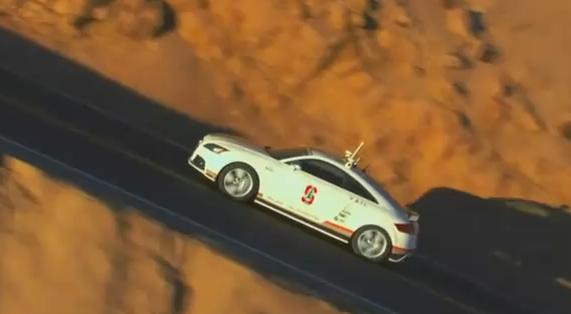
It’s a trecherous course with more than 12 miles of breakneck turns on dusty mountain roads 14,000 feet high. Pike’s Peak is one of the oldest, most impressive, and difficult races in the US, and it was just conquered by a robot. Stanford University, along with the VW Electronics Research Lab, and Oracle built an autonomous Audi TTS that could race up the peak without a human driver. Though only recently announced, the robot car made its historic run in September, just a few months after human racers competed in the 88th annual Pike’s Peak International Hill Climb. We homo sapiens still outperform our robotic creations -the top times for Pike’s Peak are near 10 minutes, while the autonomous Audi TTS took 27. But don’t rest easy my fellow humans. Robot cars have started to challenge our most extreme courses, and they’ll only get better in the future. Watch clips from the historical Pike’s Peak run in the video below. Seventeen minutes seems like a mighty slim buffer right about now.
As we covered before, Stanford’s Volkswagon Automotive Innovation Lab (VAIL) has been preparing for this run for about a year. While previous ventures into robot cars have concentrated on safe driving, the Pike’s Peak run is all about pushing the needle into the red. They don’t simply want to drive up the mountain, they want to drive fast. Really fast. Even in the most treacherous stretches of the course, the autonomous Audi TTS was still pushing 45 mph. I’m not sure about you, but I don’t play it that fast and loose when I’m on a dirt road on the back side of the mountain. Just watching the driverless Audi climb those hills gives me goosebumps. It may not be able to challenge the best among us, but this robotic car is probably getting close to my level at least.
Even though the Audi performed all its own maneuvers this race was still in controlled conditions. Members of the PPIHC were on hand to certify the car’s time for the course. According to the press release, local and state traffic officials made certain that the test could be run with the utmost regard for safety. Outside observers were kept to a minimum, and as you can see in the video, a manned car followed the Audi on its run. In that regard, this trial wasn’t all that different than the DARPA Urban Challenge, or the recent miles logged by Google’s autonomous cars. We have a highly trained robot car, but we keep it on a very short leash.
Yet even with that leash the Pike’s Peak run represents something new in autonomous driving. We’re not simply looking at a system that can perform hairpin maneuvers under strict conditions, we’re looking at a system that is challenging human supremacy on the road. It’s not just about whether we could have robot cars, it’s about whether those cars would be better drivers than we are under any circumstance. The answer for now, is no.
But how quickly will that change? Over their entire lives human drivers improve their skills, but as a whole the Pike’s Peak record only comes down a few seconds at a time. Autonomous cars have the potential to rapidly improve themselves, and to keep improving over time. At 27 minutes, the autonomous Audi is probably better than many human drivers. Every minute it shaves off its record it will overcome millions of drivers in skill. At some point in the future, there will be few, if any humans that will be able to match these cars. The gauntlet has been thrown down and robot cars are a potent challenger.
Yet when they defeat us, we will also win. Imagine a world where we have widespread autonomous vehicles, and where each of those autos has the capabilities that exceed the most experienced rally car drivers. Not only could you let your robot automobile drive for you, you could rest easy knowing that it will dodge hazards, brake for children in the road, and speed down the highway with a grace you could not produce on your own. When we can produce a robot car that can win at Pike’s Peak the whole world should rejoice, because the whole world could be made much safer.
I fear, however, that it will take much longer for us to accept these cars on the road than it will for them to master it. As I mentioned when discussing Google’s foray into autonomous vehicles, legal and social issues surrounding robot cars are likely to retard their adoption considerably. Even expert rally car drivers crash occasionally. Until we can psychologically accept our machines routinely killing innocent bystanders we will not be able to trade the millions of traffic deaths in our current world for the thousands of deaths we would have in a world with automated roads.
Automotive perfection seems closer every day, but we have to keep in mind that it will take time and global effort for it to arrive. For now we can simply enjoy watching an empty car racing up Pike’s Peak. This is just a first step towards something better. The future is going to be so cool.
[screen capture and video credit: Audi of America]
[source: AudiUSA]



